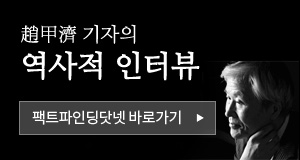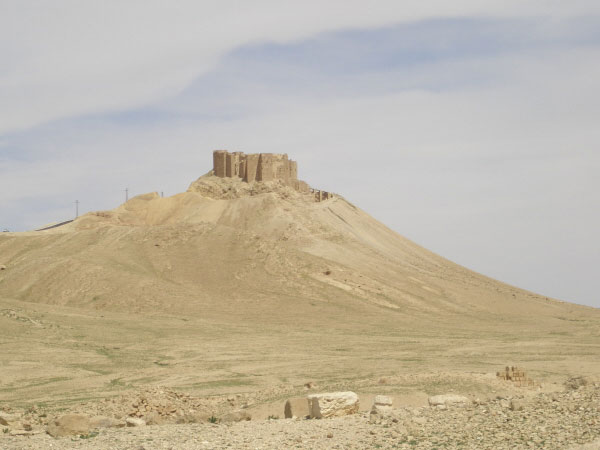
사진 :
길은 대평원을 달린다. 초원으로 변하더니 점점 나무와 풀이 줄어들면서 사막 분위기로 바뀐다. 양떼를 모는 베드윈, 텐트, 낙타가 자주 나타난다. 시리아 국토의 절반 가량이 이런 사막지대이다. 낙타는 사막의 배이다. 280kg의 짐을 싣고 천천히 걸어가면 하루에 시속 4km씩 10시간을 갈 수 있다. 짐은 싣지 않고 사람이 타고 여행하는 데는 시속 16km로 하루 200km나 간다. 굵은 눈썹과 닫을 수 있는 코가 모래먼지를 막아준다. 더위에 몸의 수분을 20%나 잃어도 견딘다. 사람은 물을 사흘만 먹지 않아도 죽지만 낙타는 10일까지 견딘다. 한꺼번에 물을 60리터나 마시고 몸안에 저장한다. 수컷은 몸무게가 평균 665kg이다.
세계 역사는 대체로 말(낙타)을 달린 민족과 배를 몬 사람들이 권력을 잡고 지배했다. 말과 낙타를 일종의 탱크 같은 兵器로 이용한 유목민족 출신들이 17세기에 소총이 등장할 때까지 세계를 지배했다. 몽골, 투르크, 아랍민족이다. 16세기를 분기점으로 하여 배를 잘 모는 포르투갈, 스페인, 네덜란드, 영국, 프랑스 세력이 세계 도처에서 식민지를 개척하기 시작하면서 大勢가 바뀐다. 세계사의 주도권이 기마민족에서 해양민족으로 넘어가는 것이다.
그래도 19세기 세계 4大 제국중 3大 제국은 유목기마민족 출신이었다. 여진족이 세운 淸, 투르크족이 만든 오스만 투르크, 몽골족의 정복왕조 무갈제국(인도). 기마민족 출신이 아닌 것은 大英제국뿐이었다.
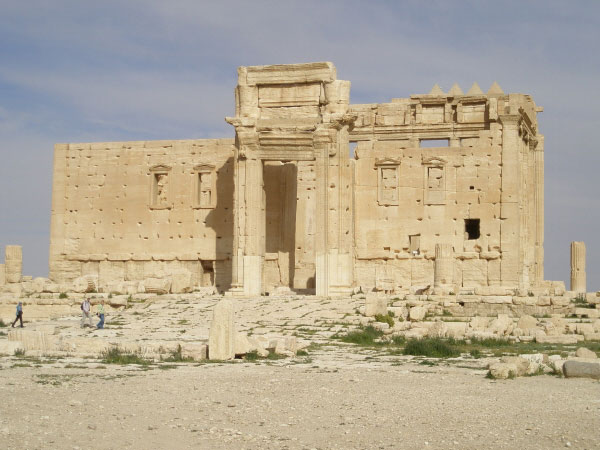
사진 :
세계사의 주도권을 잡으려면 속도의 우월성을 확보해야 한다. 화살보다는 소총이 빠르고 기관총은 더 빠르고, 배보다는 비행기, 그리고 유도탄이다. 미국의 세계 경영은 기동성에서 나오고 기동성은 가장 빠른 航母戰團, 가장 빠른 전투기, 가장 멀리 가면서 정확한 미사일에서 나온다. 세상만사가 기동성에 의해서 결정된다고 믿었던 사람들이 기마민족이요 해양민족이었다.
삼국을 통일한 신라는 말도 잘 타고 배도 잘 몬 사람이었다. 이슬람의 전성기 때 아랍사람들도 그러했다. 이슬람이란 신앙으로 무장한 아랍의 기마부대가 중앙아시아에서 스페인까지 휩쓸고 있을 때 인도양과 동지나해는 아랍상인들의 무대였다. 신라, 고려도 아랍상인들의 기항지였고 한반도 사정을 서양에 처음으로 전한 이들도 아랍인들이었다. 1970년대 중동건설 시장에 진출한 한국인들이 한때 30만 명이나 되었다. 지금도 두바이는 한국 건설회사가 만든 도시라는 말을 들을 정도이다. 아랍과 한국은 결코 멀기만 한 관계가 아니었다.
기동성((Speed)을 확보하려면 개인이든 군대이든 국가이든 가벼워야 한다. 가벼워지려면 삶이 단순해야 한다(Simplicity). 단순하게 살려면 그렇게 사는 것이 자랑스럽다는 자부심(Self confidence)이 있어야 한다. 이 3S(Speed-Simplicity-Self confidence)가 기업의 성공 비결이라고 주장한 이가 GE의 전설적 경영자 잭 웰치였다.
중동 사막의 주인공 베드윈은 몽골고원의 유목민족처럼 이웃한 중국, 이란 등 도시문명을 부러워하지 않았다. 하늘과 초원을 벗 삼으면서 유유자적하다가 도시를 공격하여 문명인들이 만든 물건을 빼앗아와서 먹고사는 삶이 더 자유롭고 근사하다고 믿었다. 그런 자부심이 그들을 도시 및 농경문화에 동화시키지 않았다.
사막과 草原의 단순성, 삶의 단순성, 美的 감각의 단순성, 그리고 이슬람과 유태교, 기독교의 단순성은 서로 통한다. 神을 거추장스럽게 우상으로 형상화하지 않았다는 점이 최고의 단순성이다. 神을 형상으로 만들었다면 파괴할 수 있지만 마음속에 神을 가진 사람은 강하다. 형상을 떠난 神이기에 어디든 존재할 수 있는 것이다. 이슬람과 유태-기독교의 세계 전파는 여기서 시작되었다. 사막의 밤하늘을 인간이 바라볼 때 느끼는 절대자의 존재감, 인간과 神의 직접 소통, 이런 사막적 감수성 속에서 인류역사를 바꾼 3大 종교가 탄생한 것이다.
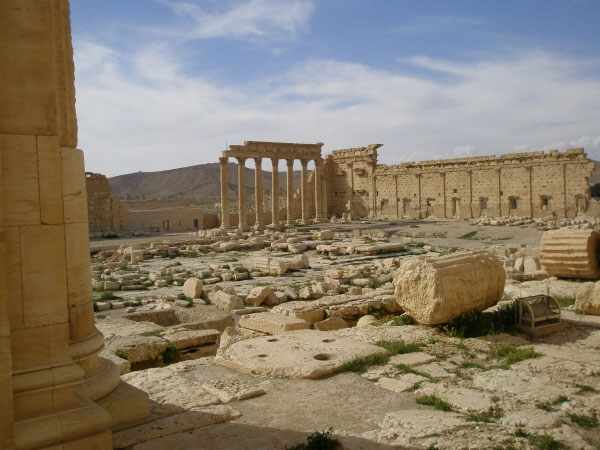
사진 :
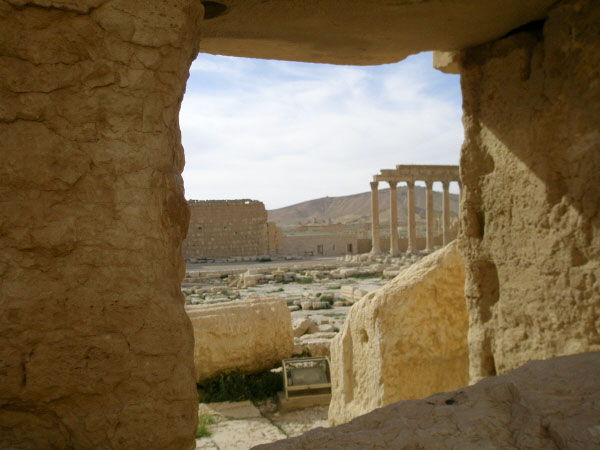
사진 :
버스는 사막속으로 더 깊이 들어갔다. 홈스에서 서쪽으로 달리는 이 길은 지중해와 이라크를 연결하는 隊商路이자 아시아 북방을 종단하는 실크로드의 서쪽 끝 부분이었다. 오늘의 목표는 이 東西 무역로의 거점이었던 오아시스 도시 팔미라(Palmyra. Palm의 도시라는 뜻. 아랍어로는 타도몰이라 불린다)이다. 팔미라로 들어가니 사막이란 바다를 항해하다가 항구로 들어가는 기분이 들었다. 모래 산이 내려다보는 가운데 나지막하게 발달한 숲의 섬이 신기루처럼 태양 아래서 자고 있었다.
서기 271년 로마 황제 아울렐리안은 우리가 왔던 경로를 거쳐 팔미라로 進軍했다. 터키 남부의 안티옥과 홈스에서 팔미라의 여왕 제노비아의 군대를 무찌른 로마 군대는 팔미라를 포위하고 관대한 항복조건을 제시했다. 자존심이 강한 제노비아는 이를 거부하고 페르샤의 도움을 청하기 위해 포위망을 빠져나와 동쪽 유파라테스 강으로 달리다가 로마 군에 붙들려 아울레리안 황제한테 끌려왔다. 그 뒤 전설이 된 제노비아의 운명에 대해선 異說이 많다. 황제가 로마에서 개선식을 거행할 때 쇠사슬에 묶인 채 나타났고 그 뒤 로마 근교의 별장에서 잘 먹고 잘 살았다는 설이 있는가 하면 로마로 압송도중 굶고는 자살했다는 설이 있다.
로마군은 팔미라를 약탈하고 주민들을 많이 죽였다. 철학자 롱기누스도 이때 죽었다. 273년 팔미라는 로마 주둔군 600명을 죽이고 또 반란을 일으켰다가 무자비하게 진압되었다. 이때부터 이 사막 도시는 亡兆를 보이기 시작했다.
제노비아는 팔미라를 거의 독립적으로 다스리던 오다이나트 왕의 부인이었다. 로마의 하드리아누스 황제는 서기 130년에 팔미라를 방문하여 자유 도시로 선포하고 세금을 거둘 권리를 주었다. 서기 212년 칼라칼라 황제는 이 도시를 로마 식민지로 인정하고 주민들에겐 로마 시민권을 주는 등 우대했다. 팔미라 군대가 로마 군과 함께 페르샤와 싸운 데 대한 보상이었다. 동서 무역로에 놓인 이 도시는 오가는 隊商들로부터 세금을 거두고 대상들이 필요한 물품을 공급하는 기지였다.
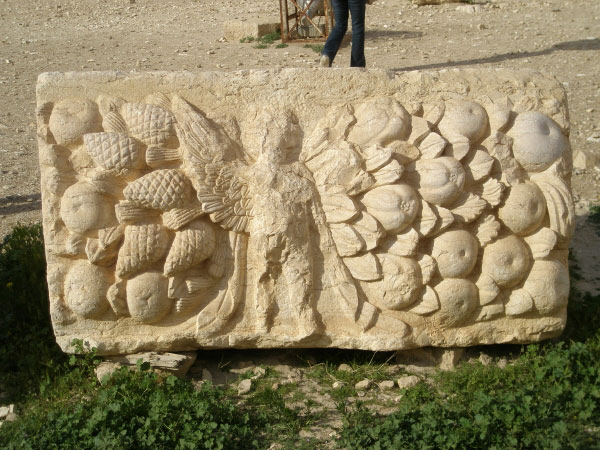
사진 :
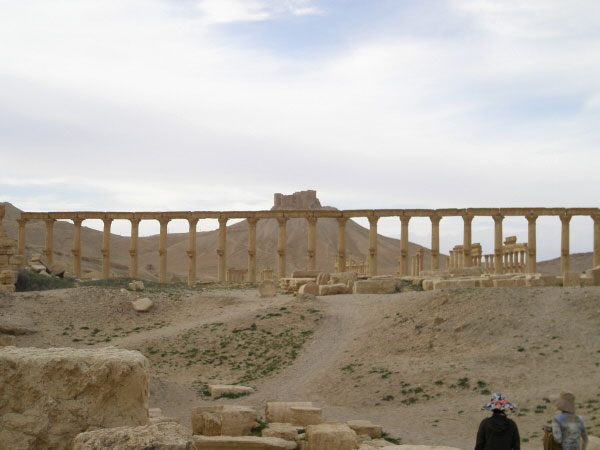
사진 :
오다이나트는 야심가였다. 페르샤의 사산朝 군대를 격파한 뒤엔 왕을 자칭했다. 로마도 처음엔 이곳에 주둔하는 로마군대의 지휘권을 주는 등 그를 우대했다. 서기 267년 오다이나트 왕이 의문의 죽음을 당한 뒤 제노비아가 실권을 잡고 아들을 허수아비 왕으로 내세웠다. 로마가 이를 인정하지 않고 진압군을 보내자 제노비아는 로마 군대를 맞아 싸웠다. 제노비아는 대단한 미인인데다가 전략가였다. 로마제국의 멸망사를 쓴 영국의 에드워드 기본은 “그녀는 미모에선 조상인 클레오파트라를 능가했고, 용기와 순결함에선 따를 여인이 없었다”고 극찬했다.
로마 군단을 격파한 제노비아는 내친 김에 로마領이던 시리아와 팔레스타인 지역 전부를 점령하고 이집트로 침입하여 항복을 받아냈다. 오아시스 도시를 큰 제국 수준으로 키운 제노비아를 로마가 그냥 둘 수 없었던 것이다.
팔미라 유적은 서기 2, 3세기 때 지은 도시 건축물의 잔해이다. 발굴된 면적은 수십만 평에 걸쳐 뻗어 있다. 로마 도시의 전형이다. 神殿, 大路, 극장, 목욕탕, 광장, 개선문, 상점가들이 발굴되어 재현되었다. 다 둘러보려면 종일 걸릴 것이다. 이 도시는 2세기의 로마 황제 셉티미우스 세베루스가 특별히 보살펴주었다. 세베루스는 북아프리카 리비아 땅에서 태어난 페니키아 사람으로서 시리아 홈스의 神殿 司祭의 딸과 결혼하여 고향 땅인 시리아에 애착이 많았다.
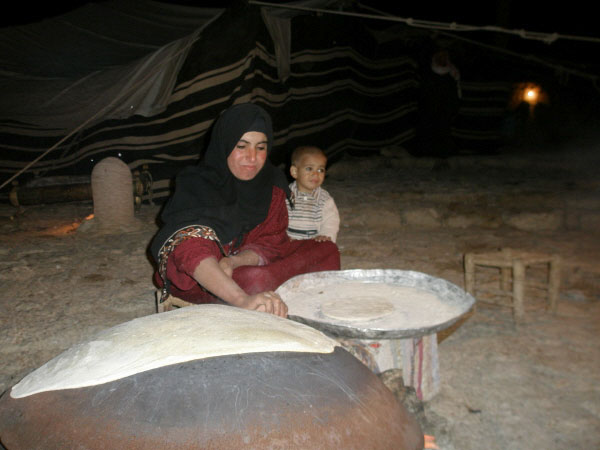
사진 :
필자는 팔미라의 이곳 저곳을 거닐다가 10代 후반의 한국 젊은이 세 명을 만났다. 청년이 둘, 여자가 한 사람이었는데 요르단을 거쳐서 버스 편으로 팔미라까지 왔다는 것이었다. 시리아에서 만난 최초의 한국인이었다. 시리아의 매력은 관광객들이 밀려 오기 전의 순수함을 유지하고 있다는 점이다.
팔미라에는 돌탑을 만들어 유해를 안치했던 로마시대 유적들이 많다. 첨성대처럼 생긴 돌탑 하나에 가족 단위로 수십 명의 유해가 보존되었다. 이곳을 구경하고 나오는데 두 살 정도의 아기를 안은 30代로 보이는 여인이 아기를 안고 사진을 찍으라고 권했다. 한 장 찍는 데 5 달러를 요구했다. 자신의 아기를 돈벌이용으로 이용하는 商術 또한 상업도시의 수천년 전통을 이어가는 듯했다. 약4만 명이 살고 있는 팔미라 근방에는 공군기지가 있다. 전투기들이 유적을 표적으로 삼고서 저공비행을 하기도 한다.
저녁에는 베드윈 천막으로 들어가 그들의 춤과 노래를 구경했다. 천막 바깥으로 나와 하늘을 보았다. 장작불 위에 솥두껑을 엎어놓고 밀가루 반죽을 그 위에 얹으면 얇게 굽힌다. 코부즈라고 불리는 빵이다. 별 보이는 밤 코부즈를 굽어내는 베드윈 아줌마 옆에 자리하여 굽혀나오는 빵떡을 1달러씩 주고 먹었다.
==================================
Battle of Talas
From Wikipedia, the free encyclopedia
Jump to: navigation, search
Battle of Talas
Part of Arab Abbasid Caliphate and the Chinese Tang Dynasty conflict over Central Asia
Date July-August, 751 AD
Location Near present day Taraz, Kazakhstan
Result Abbasid victory
Combatants
Arab Abbasid Caliphate Chinese Tang Dynasty
Commanders
Ziyad ibn Salih Gao Xianzhi
Li Siye
Duan Xiushi
Strength
50,000 to 150,000
(40,000 Khorasan troops + troops of Arab protectorates + defected Qarluq mercenaries) [1] 30,000 to 100,000
(20,000 Tang troops + troops of Chinese protectorates + Qarluq mercenaries who later defected) [2]
Casualties
Unknown Gao retreated with thousand survivors
The Battle of Talas in 751 was a conflict between the Arab Abbasid Caliphate and the Chinese Tang Dynasty for control of Central Asia. The Chinese army was defeated following the routing of their infantry by the Abbasid cavalry on the bank of the River Talas. The defeat was partly a result of the defection of Qarluq mercenaries who originally supported the Chinese. The Qarluq successfully cut the Chinese infantry off from the rest of their army. The commander of the Tang forces, Gao Xianzhi, realized his defeat was imminent and managed to escape with some of his Tang regulars.[3] Though Gao was able to rebuild his forces within months, he never again gained the confidence of the local tribes residing in the area.
The exact location of the battle has not been confirmed but is believed to be near Taraz (once named Zhambyl) in present day Kazakhstan.
Of interest to note, the Battle of Talas is seen as the key event in the technological transmission of the paper-making process, from China to the Islamic world and the West. The Chinese court eunuch Cai Lun had invented the process in 105 AD. Soon after the Battle of Talas, by the year 794 AD, a paper mill could be found in Baghdad, modern-day Iraq.
Contents [hide]
1 Historical significance
2 See also
3 Notes
4 External links
[edit] Historical significance
An almost certainly apocryphal story states that the technology of paper making was transmitted to Central Asia and the Middle East as a result of the battle, as knowledgeable Chinese prisoners of war were ordered to produce paper in Samarkand [1]. With the successful cooperation of Arabs and Turkic peoples, Islam began to exert its influence on the Turkic culture.
Shortly after, the domestic rebellion of An Lushan (755-763) and subsequent warlordism (763 onwards), the Tang ceased to be influential in Central Asia by the end of 8th century. The local Tang tributaries then switched to the authority of the Abbasids, Tibetans, or Uighurs and the introduction of Islam was thus facilitated among the Turkic peoples. Well supported by the Ummayads, the Qarluqs established a state that would be absorbed in the late 9th century by the Kara-Khanid Khanate.
Among the earliest historians to proclaim the importance of this battle was the great Russian historian of Muslim Central Asia, Barthold, according to whom it 'determined the question which of the two civilizations, the Chinese or the Muslim, should predominate in the land (of Turkestan).' [2]
However, claims that the battle itself was significant are not well-supported by historical evidence. The dry and simplistic recount of the battle itself from both Chinese and Arab sources shows that it may have been no more than a border skirmish. The prominent Muslim historian of the time, Al-Tabari did not mention this battle by name, but did refer to a battle against Chinese forces. Other than the technological transfer of paper, there is no evidence to support a geopolitical or demographic change resulting from this battle. The fact that the Tang was able to call on Central Asian auxiliaries from places such as Ferghana during An Lushan's revolt shows that Chinese influence certainly continued to exist west of the Pamirs. Not all Turkic tribes of the region converted to Islam after the battle either - the date of their mass-conversion to Islam was much later in the 10th century under Musa. [3]
[edit] See also











